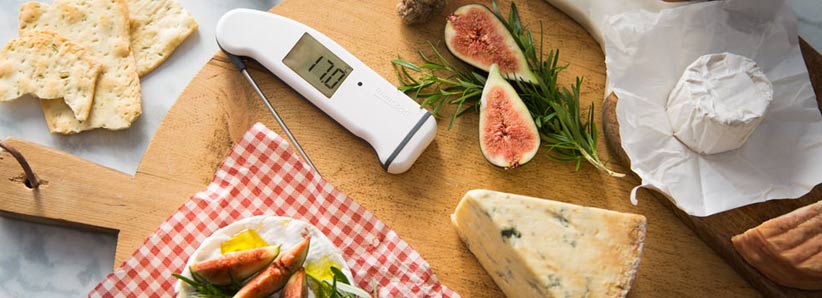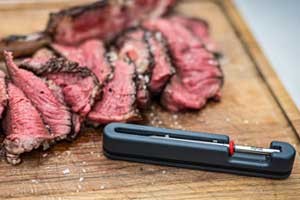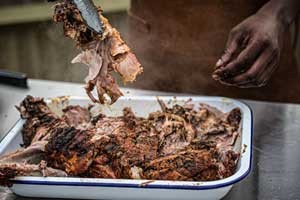Have you ever removed your meat from the heat at the perfect temperature, only to find it looks overdone once you...
Cheese & Wine Storing And Serving Temperatures
Cheese and wine go hand in hand – the perfect companions whether they’re presented beautifully to a whole host of family and friends or indulged upon on a Sunday night at home. Cheese and wine have been served together for hundreds of generations. Many farms would often produce both wine and cheese and therefore they made a natural and beautiful pairing.
However there is an art to correctly both storing and serving your cheeses and wines. If you’re looking to spend a pretty penny on some delicious wine and cheese then be sure you know how to care for them.
Serving Temperatures for wine
Vintage Port: 19°C
Bordeaux, Shiraz: 18°C
Cabarnet Sauvignon: 17°C
Pinot Noir: 16°C
Chianti, Zinfandel: 15°C
Tawny Port, Madeira: 14°C
Beaujolais, Rose: 12°C
Sauternes: 11°C
Chardonnay: 10°C
Riesling: 9°C
Champagne: 7°C
Ice Wines: 6°C
*Each variety of wine can differ slightly, this is an optimal guide. Recommended wine storing temperature 13°C
Storing temperatures of wine
Storing wine can often be a confusing minefield that feels best left to the connoisseurs. However one of the key parts to correctly storing wine is the temperature – most people can easily control this at home. Wine needs to be kept chilled, but not cold. The recommended temperature range for storing wine is 7–18°C with 13°C being agreed as the perfect temperature. Most refrigerators run at around 4°C. When the temperature drops this low, so does the humidity level, this can lead to the cork drying out and air from the fridge seeping inside the bottle and damming the wine.
Storing your wine at too high of a temperature (21°C) or above can also cause damage such as the aromas going flat.
Serving temperatures of wine
Having taken as much care as possible when storing your wine, the same care should be taken when serving. It is generally agreed upon that red wine should be served between 13–16°C, white should be served from 10–13°C, and sparkling wine 7–10°C.
Of course each individual wine will have their specific needs for an optimal serving temperature. Recommended serving temperatures will optimize the sensation of the wine’s bouquet, body, tannin, acidity, and subtle flavors such as floral, earthy, or fruity. See our table above of recommended wine serving temperatures.
Of course to be sure that your wine is being served at the correct temperature you will need a thermometer. We recommend using our Thermapen thermometer, with its 1 (Thermapen ONE) and 3 second (Thermapen Classic) response time and handy rotating probe it is ideal for quickly reading your temperatures before serving.
Once you have removed your wine from storage you should either pop the bottle in the fridge to chill (white wine or sparkling) while red should be left out to acclimatize.
Simply pop the thermometer probe into your wine before and after serving to ensure the optimal temperature for the perfect taste.

Storing temperatures of cheese
There is nothing quite like a wonderful platter of artisan cheeses. However each artisan cheese has its own temperature requirements when being stored. Most cheeses should be kept at 10–16°C and in a dark, humid area. This temperature range is colder than room temperature but not quite as chilled as the fridge, a pantry, cellar or even a wine cooler is about right. If cheese is stored at too cold of a temperature then the cheese’s active bacteria goes dormant.
The correct temperature will allow cheeses to continue developing their complex flavours and age appropriately.
Top Tip: When storing cheese you should also loosely wrap it in breathable waxed or parchment paper instead of a sealed plastic wrap.
Serving temperatures of cheese
Cheese is no different to many other foods in the fact that they are best served when at their optimum temperature.
Cheese is best served at room temperature (18-24°C), this softens the milk fat leading to a more pleasant texture. At colder temperatures the milk fat in cheese becomes hard and waxy, much like cold butter. Serving cheese at cold temperatures directly from the fridge also subdues its complex flavors and aromas.
Serving cheese at too warm of a temperature (27°C or above) can result in the cheese ‘sweating’. At this point the milk fat begins to melt and surface on the outside of the cheese, giving it the appearance of beads of sweat.
The best way to serve your cheese at room temperature is to remove them from the fridge and arrange on their platter a full hour before you intend on serving them. Just before serving be sure to check the internal temperature of each cheese with your Thermapen.
Related posts
 Italian Meringue with Baked Apricots & Hazelnut Cream
Italian Meringue with Baked Apricots & Hazelnut Cream
 Mike Tomkins’ Rib of Beef with Potato Terrine Chips & Charred Hispi Cabbage
Mike Tomkins’ Rib of Beef with Potato Terrine Chips & Charred Hispi Cabbage
 Mike Tomkins’ Hunter’s Chicken
Mike Tomkins’ Hunter’s Chicken
 Fish Tempura with Sauce Gribiche
Fish Tempura with Sauce Gribiche
 Swedish Cinnamon Buns
Swedish Cinnamon Buns
Search
Categories
- Baking (34)
- BBQ (81)
- Autumn (14)
- Cheap Eats (9)
- Sweet Treats (38)
- Tips, Advice & Info (77)
- Christmas (35)
- Drinks (1)
- Thermapen Father's Day Recipes (17)
- Team Temperature (23)
- Date Night (37)
- Celebrations (20)
- Family & Kids (9)
- Fish (21)
- Low & Slow (11)
- Meat (138) click
-
Chefs (128)
click
- Kenny Tutt (16)
- Richard Holden (16)
- Barbechoo (5)
- Only Slaggin (1)
- SoSaSe Chocolat (1)
- Genevieve Taylor (5)
- Becky Excell (2)
- Charlotte Stirling-Reed (3)
- The Smokin Elk (12)
- Marcus Bawdon (2)
- Thermapen Chef (25)
- Edd Kimber (2)
- Humble Plates (7)
- Simon May (4)
- The Hedgecombers (3)
- Billy & Jack (4)
- Perfectly Preserved (3)
- Mike Tomkins (19)
- DJ BBQ (2)
- Nick Nairn (4)
- Air Fryer (9)
- RFX (3)
Latest recipes

There’s nothing like tender smoked pork belly piled into soft tacos, especially when topped with tart homemade...

Reverse-seared tomahawk steak cooked on the BBQ. Served with a rich and flavourful cowboy butter sauce.

Smoky, tender pulled pork cooked on the BBQ. Served in soft tacos with homemade salsa and spicy mayo.
Archive
Popular Recipes








